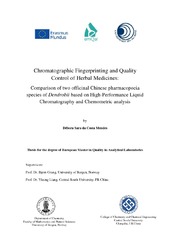Chromatographic Fingerprinting and Quality Control of Herbal Medicines: Comparison of two officinal Chinese pharmacopoeia species of Dendrobii based on High-Performance Liquid Chromatography and Chemometric analysis
Master thesis
Permanent lenke
https://hdl.handle.net/1956/7514Utgivelsesdato
2013-08-29Metadata
Vis full innførselSamlinger
- Department of Chemistry [433]
Sammendrag
The fingerprinting quantitative analysis combining similarity evaluation, Principal Component Analysis (PCA) and Partial Least Squares Discriminant Analysis (PLS-DA) is a valid method for classification of herbal medicine species. The main objective of this study was to investigate the chemical differences between two officinal Chinese pharmacopoeia species Dendrobii Caulis (Shihu) and Dendrobii Officinalis Caulis (Tiepi Shihu). As far as is known no systematic chemical differences study between the two species, especially based on Dendrobii whole profile, was done before. A total of twelve samples, six from each species collected from five different provinces in China were analyzed in China at Central South University (CSU) and in Norway at University of Bergen (UiB). The extraction method of flavonoids or other phenolic compounds present in the two different species of Dendrobii and the sample preparation were developed and were relatively simple processes. The main advantages of these processes were low solvent consumption, relatively short extraction time, good extraction efficiency, stability and repetitiveness. The HPLC-DAD method was developed to separate the components present in the two species of the Chinese herbal medicine (HM) Dendrobii with good resolution. Based on the optimization of the chromatography conditions, an efficient chromatography fingerprint of these species was established. It was verified that some compounds with retention times in the range from 40 to 50 min appeared in Dendrobii species but not in Dendrobii Officinalis species. All the samples were analyzed at four different wavelengths, the results obtained at 254 nm being the most useful. PCA results showed that the distribution of the samples in two groupings before and after peak alignment is almost the same revealing the similarity between the two species. Regarding PLS results, it was observed a regular relationship between the Dendrobii samples and between the Dendrobii Officinalis samples with a clear separation between the two different clusters. In the results obtained for one wavelength or even four wavelengths, the final predictive properties of the models were good due to the low values obtained for the Standard Error of Prediction (SEP). The selectivity ratio showed specific regions in the raw data that could help distinguish between the two Dendrobii species. The method established by this study could be applied to other similar Dendrobii species for the quality assessment.
